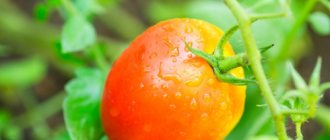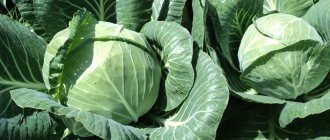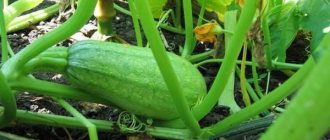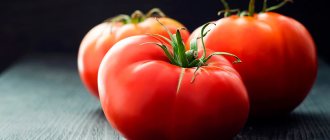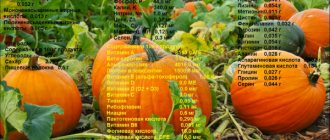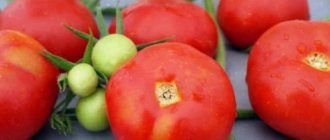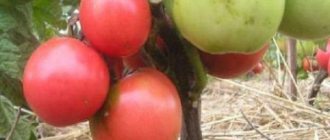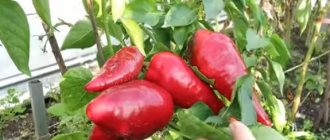Tatyana Panasenko Decided to try a new variety
Growing hybrids involves the absence of your own seeds, which is not very convenient. And then I decided to try the Iskander F1 variety of zucchini. Reviews about it were very good. There were only 5 seeds in the bag - just enough for testing, but generally not enough.
I planted them along with other seeds directly into the garden bed. Everyone has ascended! Neat bushes quickly formed and fruit set. The variety amazed me with its harvest.
Article – review of the zucchini variety “Iskander” F1, its description, characteristics, cultivation and care
This article will focus on one of the foreign varieties of zucchini obtained as a result of selection - “Iskander” F1
.
This variety of zucchini may well become a pleasant discovery for those who have not yet heard anything about it. The first generation Iskander has a juicy, pleasant taste. In addition, it does not require complex care. You can look at numerous reviews and photos on the Internet.
The content of the article:
History of the variety Zucchini Iskander: description of the variety Zucchini Iskander: rules for growing the variety How to prepare zucchini seeds for planting Soil preparation Planting zucchini Iskander directly in open ground Further care for zucchini Iskander Diseases and pests of squash crops Yield of zucchini variety Iskander F1 Reviews of zucchini Iskander
History of origin of the variety
Zucchini "Iskander" F1 (Eskanderany f1) refers to varieties bred in Holland. It is very popular. The purpose of its creation was the possibility of early cultivation both in a greenhouse and in open ground.
In Russia, this variety received registration in 2001. The first trial cultivation took place in 2001, in the Krasnodar region.
You can see what early-ripening Iskander squash looks like in the photo.
Zucchini Iskander: description and characteristics of the variety
Zucchini "Iskander" F1 came to us from Holland; below is a description of the variety.
Iskander is a hybrid belonging to early ripening varieties
. The fruits of this variety are capable of setting even at temperatures below zero. The first fruits appear already on the 45-50th day.
In appearance they look like ordinary zucchini, nothing unusual. Zucchini has an oblong shape in the form of a cylinder. A medium-sized zucchini reaches 20 cm in length and weighs 600 grams. The top of the fruit is covered with delicate, light green skin, with a waxy coating.
Only by looking closely can you detect thin veins and specks. The white flesh of the squash is as tender as the surface. The 1st generation Iskander variety has special taste characteristics
.
Important:
Be sure to use a staking of zucchini bushes to maintain the shape of the crop as it grows.
How to sow?
Iskander's seeds are milky in color and elongated. The core is hidden under a hard shell. If dark or yellow spots appear on the shell, then such material is discarded.
Additionally, the seeds are kept in water to determine their quality. Only those that have sunk to the bottom of the container are suitable for sowing.
The manufacturer usually indicates on the packaging what manipulations were performed with the seed. Seeds can be treated with an antiseptic and a growth biostimulator. In this case, they only need to be germinated. They ripen in a damp cloth for 3 days.
They are left at room temperature during the day and put in the refrigerator at night. The seeds immediately get used to temperature changes. It will be easier for them to adapt to open garden beds.
Gardeners recommend re-treating the seed with a 1% solution of potassium permanganate or keeping them in an ash solution. You can awaken the seeds with melt water or Epin solution. Take 2.5 ml of the drug per 5 liters of water. These events will awaken the seeds and launch metabolic processes in the core:
- sowing is carried out in soft, loose soil. Make wide holes. The manufacturer must indicate the sowing scheme. For Iskander variety zucchini, the diameter of the hole is 60 cm. A distance of 60-70 cm is left between the beds;
- in the center, use a scoop to make a hole 5-6 cm deep;
- put 2-3 seeds in it. If seedlings appear from all the seeds, then it is necessary to transplant the seedlings into separate beds;
- After sowing, the seeds ripen under the film. The soil is ventilated daily;
- Water the holes as needed. If the soil is wet, then additional watering can cause waterlogging.
The first watering can be done after 3-5 days. Use irrigation from a spray bottle. Instead of water, you can prepare a solution of humates or the Zdraven preparation. The following use of these products is permissible only before the appearance of inflorescences. The temperature of the irrigation liquid is 20 C.
The first shoots from germinated seeds appear after 7-10 days, from non-germinated material after 10-14 days.
The film is removed, but if by this time the air has not warmed up to 20-25 C, it often rains, and there may be frosts at night, then it is better to provide a film tunnel for the seeds. You can sow seeds in the greenhouse at any time. The main thing is to maintain a certain microclimate for them.
Advantages and disadvantages of the variety
Among the undeniable advantages of the Iskander variety are early ripening and large harvest volumes.
For clarity, I will provide statistical data:
- in one season it is possible to harvest up to 17 kg of vegetables. And this is from one bush;
- Zucchini is capable of bearing fruit even at low, sub-zero temperatures. Fruiting continues even during cold periods;
- Low maintenance requirements.
Hybrid zucchini "Iskander" has a short shelf life
. This is mainly inconvenient for large farms that grow vegetables for sale. For me this is not a disadvantage.
Photo of Iskander zucchini seeds
Zucchini Iskander: sowing and growing a hybrid
I’ll tell you in more detail about how to properly sow Iskander zucchini seeds, grow and properly care for the variety.
Preparing seeds for planting
There are two ways to plant the Iskander squash variety:
- growing seedlings;
- sowing seeds directly into open ground in their original form.
Growing Iskander zucchini - video
In both cases, you need to prepare the seeds themselves for planting.
.
Seeds require moisture to germinate. To do this, soak them in warm water. The temperature of the water for soaking should be at least 20 degrees
. It is allowed to add nutrients to the water.
The soaked seeds must be removed from the container, wrapped in a damp material made of thick fabric. Leave the seeds in this state for 3 days. Keep an eye on the fabric in which the seeds are located, and if necessary, moisten it. Store at a temperature of 25-26 degrees above 0.
There is another method to prepare seeds for planting: cooling
. To do this, seeds for germination are placed in the refrigerator for 15 hours. After this, they need to be warmed up well at 22-23 degrees. You can repeat the process a couple of times for better sprout pipping.
Note!
Iskander zucchini belongs to the first generation hybrids, so its seeds are not suitable as planting material for next year.
Preparing the soil for growing crops
It is necessary to prepare the soil in the fall. To do this, they carry out digging, enrichment with nutrients, and application of fertilizer. In the spring, loosening, leveling, and marking of beds are carried out.
Important!
The soil is preferably slightly acidic. You should not grow the crop in the area where pumpkins were previously grown.
The early ripening variety Iskander can be planted in open ground in mid-spring, immediately after the end of frost (if the climate allows).
It is advisable to choose sun-warmed areas for planting.
Seeds are immersed in the soil 7-8 cm
. After planting, water immediately with warm water.
Technology for planting Iskander zucchini with seeds in open ground
If you choose to grow Iskander zucchini, bypassing the stage of sowing seeds for seedlings, the timing of planting directly into the ground is postponed to late spring - early summer.
Planting Iskander zucchini with seeds directly into open ground should be done as follows:
- Make furrows on the prepared soil;
- The seeds are inserted with a sharp end into the heated soil;
- Sprinkle a thin layer of earth on top;
- Carry out watering.
At first, you can use film to cover the seedlings, simulating the conditions of a greenhouse.
Preparing and germinating seeds
If you want to get guaranteed quality fruits of the Iskander variety, then it is best to purchase seeds from sellers with a proven reputation: farms or specialized stores. In this case, seed calibration is not performed.
After 24-48 hours, the seeds hatch and roots appear. By this time, the bed should already be prepared, since a delay will lead to rapid growth and tangling of the roots.
To grow in seedlings, gardeners use the “snail” planting method:
- Take a backing for the laminate with a width equal to the width of toilet paper and a length of 60-80 cm;
- A double layer of toilet paper is placed on it, which is soaked in a solution of a growth stimulator;
- Seeds are placed on toilet paper at a distance of 0.5 cm from the edge of the strip with the sharp end inward. A gap of 5-7 cm is left between the seeds;
- A double layer of toilet paper is placed on top again, which should become wet from the first layer. If this does not happen, this layer is also thoroughly moistened with the stimulating liquid;
- Then the entire structure is carefully, without squeezing, rolled into a roll, secured with an elastic band and placed in a transparent polyethylene bucket so that the seeds are at the top of the roll;
- You can place several of these “snails” in a bucket, then you don’t need to secure them with anything. And if you cover the bucket with a lid and place it on the window, a greenhouse effect is created, and after 3-4 days there will be ready-made seedlings in the bucket without much labor.
Recommendations for caring for Iskander zucchini
After the plants have taken root, you definitely need to look through the beds and weed where necessary. Weak, ungerminated sprouts are removed along with the weeds.
Regular loosening of the soil is mandatory
to provide air to the root system. Until the growing season, regular watering is required.
After the growth and development of the plant has begun, it is worth watering periodically.
.
Be sure to take into account weather conditions, which are different in all regions of our large country.
Important!
The most common mistake is watering the plant under the root during hot periods. In this case, it is worth making a small furrow along the planted zucchini and filling it with moisture.
Care
Considering the unpretentiousness of Iskander zucchini, for their growth and development it is enough to provide food in a timely manner, regularly carry out irrigation activities, loosen and mulch the soil.
Weeding
To get rid of weeds, you need to periodically weed the garden bed. Otherwise, harmful plants will take not only moisture, but also nutrition, weakening the Iskander zucchini.
Loosening
Considering the close location of the root system of Iskander zucchini, you need to loosen the soil very carefully. If the roots are injured, the plants will take a long time to recover.
Top dressing
When the Iskander zucchini has two true leaves, add a mixture of ammonium nitrate (20 grams), potassium nitrate (20 grams), superphosphate (40 grams) and 10 liters of water. In the ovary formation phase, a composition of superphosphate (50 grams) and potassium nitrate (50 grams) per 10 liters of water is used. The same fertilizing is used at the fruiting stage.
How to properly shape zucchini and pinch climbing varieties in open ground
Read
Pests and diseases of zucchini
There are two main types of diseases common among squash crops: insect pests and fungal diseases. Zucchini of other varieties are also susceptible to it.
Pests that attack Iskander zucchini include:
- wingless;
- aphids;
- spider mite.
Excessive soil moisture can lead to fungal infection - anthracnose.
.
For powdery mildew
characterized by round white spots. They appear as a result of dampness, cold, and drafts.
High humidity and sudden temperature changes provoke the appearance of white rot.
.
You can fight pests and diseases of zucchini using products that are offered in large quantities in specialized stores.
.
Characteristics of fruits and yield of the zucchini variety Iskander
The Iskander F1 hybrid stands out from the rest due to its “fertility.” The yield of the variety can reach 17 kg per bush. It is in the first positions in terms of fruiting period. Harvesting is recommended to be done in a timely manner, before the first frost appears.
Photo of Iskander zucchini harvest on a bush
You don’t have to wait until the fruits fully ripen. Young zucchini, more than 10 cm long, with a fallen flower, have excellent taste.
The zucchini must be carefully cut, and under no circumstances should you try to pull it out with your hands (it’s still not a turnip). It is enough to make a cut at a level of 4-5 cm from the end of the stalk.
Good varieties of carrots!
Autumn King Flakke
You can store Iskander zucchini for up to 5 months.
The following conditions are required for this:
- It is recommended to pick vegetables for storage when they are fully ripe;
- The temperature in the storage room should not exceed 10 degrees;
- Dry indoor atmosphere.
By providing optimal conditions for the plant, in return you can get a rich yield of high quality.
In general, my attitude towards the Iskander zucchini variety is positive
. I've been growing it for three years now. There are no particular difficulties with planting, growing, or caring for them. The fruits ripen quickly. I really like the delicate and soft taste. It distinguishes the Iskander variety from other zucchini. In my opinion, this variety has no analogues and produces fruits of very high quality.
Excellent productive variety!
Zucchini variety “Roller”
Reviews from amateur gardeners
I ordered Iskander F-1 hybrid seeds from the online store. Seed germination is excellent. They bore fruit for two months. Once I wasn’t at the dacha for two weeks and thought that my zucchini had become coarse in taste, like fodder. But nothing like that. The harvest was great. Bravo! Olga Petrovna, Novocherkassk.
I’ve heard about the Iskander variety for a long time. Last year I bought one bag at the store. Very tasty and high-quality fruits grew, we ate zucchini all summer and prepared canned food for the winter. Irina, Mr. Bryansk.
I used to grow zucchinis because they can be kept fresh until the New Year. No need to fuss with canning. I took out the zucchini and cooked it. When they told me that the Iskander F-1 can also be stored in the basement, I did not believe it. Its skin and pulp are very tender. But the fruits survived safely until January. Ivan Grigorievich, Stavropol region.
